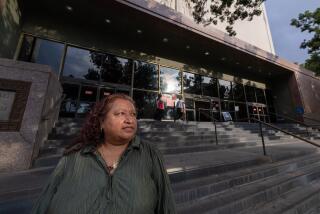Debtors prison a thing of the past? Some places in America still lock up the poor
Reporting from Seattle — Unemployed and fighting to stay clean, Jayne Fuentes had few options when a judge offered her a particularly unappealing choice – go to jail or spend her days on a work crew.
Her crime? Being too poor to pay the fines and court costs that came with a drug conviction and several theft charges.
“But when I was done with the work crew, I still owed $2,700 on another debt,” says Fuentes, 48. “I could have ended up in jail again.”
Instead, the threat of being back behind bars or assigned to another work detail vanished last week when a lawsuit filed by Fuentes and two others ended with an agreement to abolish a local practice of locking up people who can’t pay their fines and have little hope of doing so.
Similar pay-or-stay practices are used by cities and counties across the country, tactics the American Civil Liberties Union is working to end, says spokesperson Doug Honig. He cites recent settlements or decisions in Biloxi, Miss., Colorado Springs, Colo., and the Detroit suburb of Eastpointe, Mich.
NEWSLETTER: Get essential California headlines delivered daily >>
The Colorado lawsuit revealed 800 cases of people jailed for inability to pay minor violations. Most were homeless and cited for panhandling or sleeping in a park. The federal government has also been active in pursuing such practices, most notably forcing Ferguson, Mo., to discontinue its lucrative pay-or-stay policy that fell hardest on minorities.
“Across the country,” said ACLU staff attorney Nusrat Choudhury, “counties and cities seeking revenue are using jail and forced labor to coerce poor people to pay fines and fees they cannot afford.” The recent court victories “will help ensure that people’s freedom no longer rests on their financial circumstances.”
In Fuentes’ community, Richland, Wash., which hugs the Columbia River in Benton County, local officials had not been bashful about jailing indigent district court defendants to help generate government revenue. One survey of Benton County Jail showed there were an average 88 prisoners a day serving time for fines they couldn’t pay – about 28% of the jail population.
Last fall, after Fuentes’ lawsuit was filed with the backing of the local ACLU chapter and Terrell Marshall Law Group of Seattle, Benton County commissioners wondered whether there were any other ways to get the poor to pay up.
“Can’t [the county] go after their welfare or anything?” asked Commissioner Jerome Delvin.
Commissioners surrendered shortly afterward and ended what the suit called “a modern-day debtor’s prison” policy, potentially costing the county several million dollars in lost revenue. The ACLU pushed ahead with the suit to get the county’s concessions in writing, including an agreement to no longer punish those too poor to pay.
In Benton County, during one 6 1/2-month period, 320 inmates were found to be serving time because they were unable to pay fines, according to the lawsuit. They owed an average of $2,670 each. One person owed $17,000, which could take up to 345 days of jail time to pay off.
Whether the defendants picked jail or a work crew, the county stood to profit, the ACLU said. The cities where defendants were originally charged paid the county $70 a day for each jail cell occupied by a prisoner sitting out his or her fine. At the same time, defendants on work crews were doing landscaping, janitorial jobs and other “substantial” duties the county would have had to pay for, the ACLU said.
In Benton County and elsewhere, the ACLU won its legal challenges by pointing to a U.S. Supreme Court precedent that defendants can’t be jailed simply for being poor. Ability-to-pay hearings must be held, payment plans should be established if necessary, and any sentences should involve noncustody punishment such as community service, attorneys successfully argued.
It seemed to make more sense that I get a paying job and pay on the debt, and do public service.
— Jayne Fuentes, jailed for inability to pay fines
Fuentes, the lead plaintiff in the Washington case, was a drug abuser convicted of three minor thefts and had amassed $3,000 in court fees, including restitution and payment for a public defender.
She agreed to a payment plan but – being either incarcerated, unemployed or homeless – failed to keep up.
See the most-read stories this hour >>
Fuentes ended up doing a year in prison on felony drug charges, while the district court debt continued to grow as interest was added on. When she was released in 2013, she was brought back to court and agreed to work off as much debt as she could.
“It seemed to make more sense that I get a paying job and pay on the debt, and do public service,” Fuentes said. She said she was able to pay down her debt at a rate of $80 a day by doing groundskeeping and litter patrol, better than the $50 a day she would earn in credit by sitting in jail.
Fuentes’ work-crew credits wiped out several thousand dollars she owed. But she’s not sure how she’ll pay the remaining $2,700. She’s on a $65-a-month payment plan, and doesn’t like to think how long repayment might take.
“I owe it; I’m responsible,” says Fuentes, who is single, lives with two roommates, and has been drug-free for several years, she says. She now makes about $10 an hour at a fast-food restaurant and was able to buy an older used car and auto insurance. But her income covers only the bare essentials.
She and two other defendants did get a settlement fee from the county – $1,000 each. That will ease the load, she says.
“This wasn’t about trying to get out of paying my fines,” Fuentes said. “If I had to go back to jail I’d lose my car, my house – everything I worked for. Maybe now I have a chance.”
ALSO
LAPD officers get a crash course in all things Korean
How a cop and his wife found peace after the Sandy Hook massacre
Swedish grad students who pinned down Stanford sex offender speak out
Anderson is a special correspondent.
More to Read
Sign up for Essential California
The most important California stories and recommendations in your inbox every morning.
You may occasionally receive promotional content from the Los Angeles Times.










